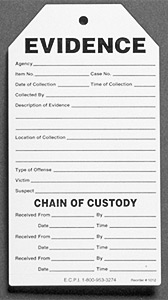Home | Glossary | Resources | Help | Contact Us | Course Map
Archival Notice
This is an archive page that is no longer being updated. It may contain outdated information and links may no longer function as originally intended.
Evidence Submission
An established format for evidence submission and documentation assists in providing consistent information. The submission of evidence and the request for examination(s) can be documented using a laboratory request form or a letter of transmittal. This documentation is not only required by the laboratory for the acceptance of submitted evidence, but is also subject to discovery.
Evidence that is hand-carried or shipped should include the following:
- Individually packaged evidence items
- Packaged items inside a sealed container
- Letter of transmittal or laboratory request form from the submitting agency requesting examination(s)
- Copy of letter or form enclosed within the sealed container
- Copy of letter or form affixed to the exterior of the shipping container
Since transmittal letters can vary greatly in format, laboratories frequently request that agencies use an established form or format when submitting evidence.
Documentation
Elements for evidence submission transmittal letters or laboratory forms may include the following:
- Agency identification
- Names of suspect(s) and victim(s)
- Numerical agency case identifier
- Characterization of the violation (e.g., homicide, burglary, assault, etc.)
- Date and location of the crime
- Investigative summary of the incident
- Related photographs and other crime scene documentation
- Method of delivery (hand-carried, shipped)
- Description of the items of physical evidence, including the corresponding item number
- List of requested examinations
- Notation of interrelated past or current case(s)
- Reference to any relevant previous submission(s)
- Request for expedited treatment of the case
- Chain of custody
Receipt of Evidence
Based on laboratory protocol, evidence is typically delivered to evidence reception personnel rather than directly to an examiner. The evidence reception personnel should provide a receipt for each submission as documentation for laboratory and agency records. Personnel receiving evidence should immediately inventory and document the contents of the submission, reporting any discrepancies.
Proper delivery assists in
- maintaining the chain of custody,
- enabling laboratory management to assign and track case progress,
- maximizing the effectiveness of the laboratorys internal case-tracking system.
Additional Online Courses
- What Every First Responding Officer Should Know About DNA Evidence
- Collecting DNA Evidence at Property Crime Scenes
- DNA – A Prosecutor’s Practice Notebook
- Crime Scene and DNA Basics
- Laboratory Safety Programs
- DNA Amplification
- Population Genetics and Statistics
- Non-STR DNA Markers: SNPs, Y-STRs, LCN and mtDNA
- Firearms Examiner Training
- Forensic DNA Education for Law Enforcement Decisionmakers
- What Every Investigator and Evidence Technician Should Know About DNA Evidence
- Principles of Forensic DNA for Officers of the Court
- Law 101: Legal Guide for the Forensic Expert
- Laboratory Orientation and Testing of Body Fluids and Tissues
- DNA Extraction and Quantitation
- STR Data Analysis and Interpretation
- Communication Skills, Report Writing, and Courtroom Testimony
- Español for Law Enforcement
- Amplified DNA Product Separation for Forensic Analysts


